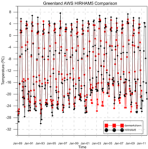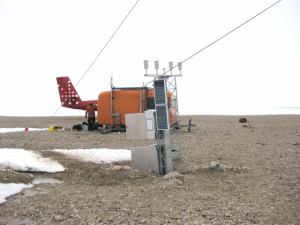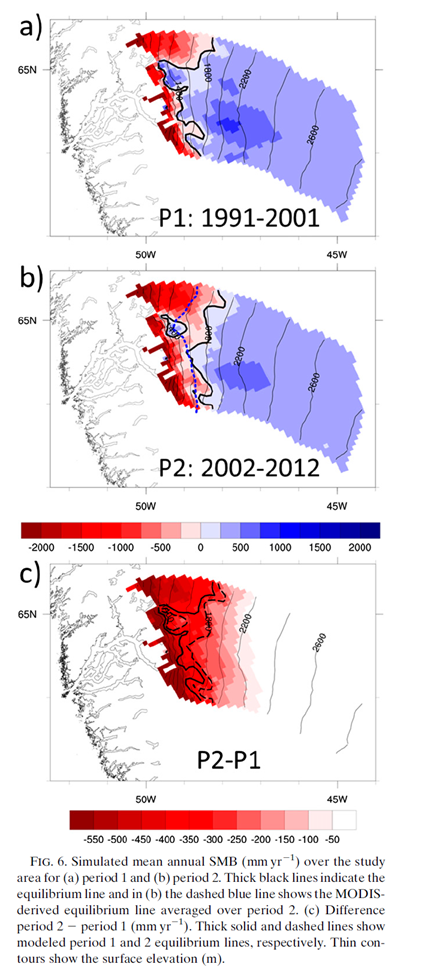UPDATE: I don’t really touch on the issue of availability of data in this post but a post by Victor Venema has just come to my attention urging the WMO to agree a free data convention to free up climate data archives for science purposes. I urge you to read it and support. In Greenland at least we are lucky most of the data is open access, but we also rely on other data sources that are not…
One of the problems all modellers face, but particularly in remote regions of the earth like Greenland, is the lack of available independent observational data which can be used to compare with model output to see how well the model simulates reality.


I actually spend much more time trying to model the recent past (say the last 35 years or so, almost my whole lifetime), rather than the future. We can compare the model output with specific metrics to assess if the model is representing any particular processes well or poorly. If the latter then clearly we need to do a bit of work to improve it, or alternatively we can gain an insight into how a particular process or system works. This is a gigantic topic to explore and I recommend the blogs Variable Variability from Victor Venema and the Climate Lab Book from Ed Hawkins and Doug McNeall if you really want to get into it.
(As an aside and related to my previous post, I generate model output faster than I can look at it, so any students who are interested in a project looking at observations and model output for any/all of various locations in the Arctic do get in touch. I have some particularly interesting results from Devon Island I don’t really have time to get into right now…)

At a recent meeting in Sheffield we had much discussion on using data from Greenland to evaluate how well the different climate models are performing over Greenland. This is complicated by the generally short records and limited geographical coverage of meteorological observations. Often those observations are made in easy to get to places rather than the places we really need them such as the South East of Greenland where most of the precipitation falls. So here is a quick run down of the met observations I do have access to.
The gold standard of met observations, following guidelines set by the WMO, are the DMI weather stations (pdf ) which are largely confined to the coast of Greenland, plus Summit station at the top of the ice sheet, but have records going back, in some cases, to the 18th century. This data is all publically available and can be downloaded in a zip file from DMI.

On the ice sheet itself the GC-Net project has set up automatic weather stations on the ice sheet. This data is also pretty freely available, but it does have some quality problems as with any dataset from instruments operating in incredibly tough environments. These instruments are high up on the ice sheet in the accumulation zone, more recently the Danish funded PROMICE project, with whom I work quite closely, have been putting automatic instruments out in the ablation zone. Although these instruments are lower the conditions are also quite tough as the snow and ice under the stations melts out each summer and in some locations the piteraq is also very challenging with 150km/h wind speeds measured during one storm in 2013.

The data from Promice goes back only to 2008 but has been quality checked and homogenised so it is much easier for modellers like me to work with and it comes from a zone that is particularly important to understand. As the climate changes we expect the ablation zone to get bigger and melt to increase with some important but difficult to model processes such as retention and refreezing and albedo changes playing a big role in how quickly the Greenland ice sheet will contribute mass to the oceans.
There are of course also a number of other automatic weather stations operated by other projects and agencies, including the K-transect instruments, operated by University of Utrecht IMAU which are also associated with a long time series of mass balance measurements based on stakes drilled into the ice sheet.
For precipitation measurements, which are notoriously difficult to make especially with blowing snow, we tend to rely on shallow cores and snow pits, though again these are only available in the accumulation zone. This open access paper by our friends at the University of Copenhagen‘s Niels Bohr Institute is a very nice summary of all the measurements available. Unfortunately there are very few shallow cores taken after 2000 and even fewer taken where we need them in the south east.

I will end with a plea: all of these measurements are made possible only with budgets that have a continuous downward pressure on them. We rely on them for the weather forecast and for climate research, if you use any of this data do remember to acknowledge it. A lot of time effort and money has gone in to making those measurements, once a station is removed it’s pretty hard to get it back again. When the DMI stations were set up no-one was really thinking of climate change, they were more concerned with shipping and later on aviation and yet we now find them some of the most valuable datasets we have making measurements in a very data-poor region, the Arctic. That is true data gold.






